2011 Peugeot 308 SW BL Automatic
[x] Cancel search: AutomaticPage 130 of 336
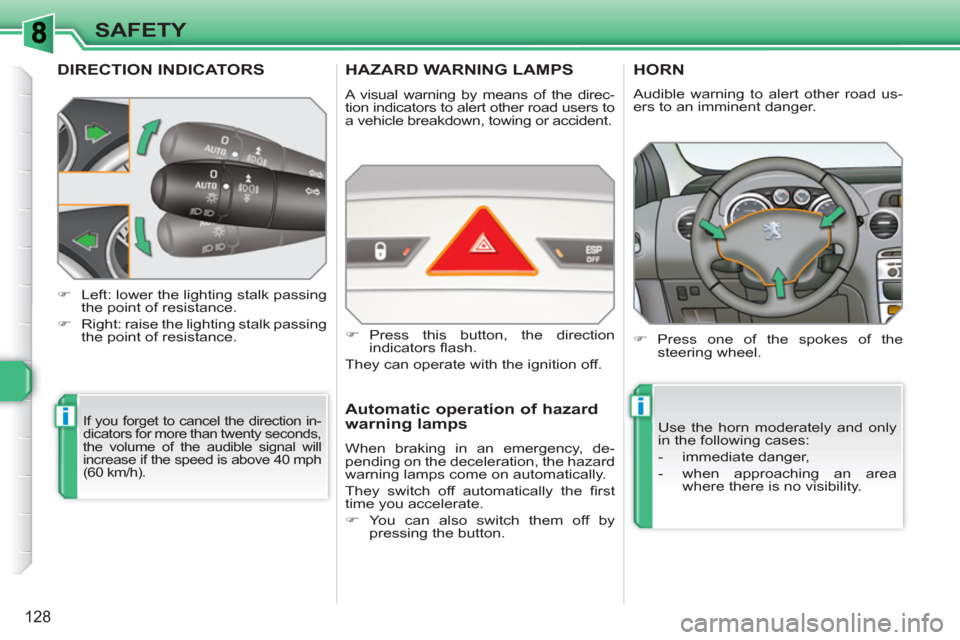
ii
128
SAFETY
DIRECTION INDICATORS
If you forget to cancel the direction in-
dicators for more than twenty seconds,
the volume of the audible signal will
increase if the speed is above 40 mph
(60 km/h).
�)
Left: lower the lighting stalk passing
the point of resistance.
�)
Right: raise the lighting stalk passing
the point of resistance.
HAZARD WARNING LAMPS
A visual warning by means of the direc-
tion indicators to alert other road users to
a vehicle breakdown, towing or accident.
�)
Press this button, the direction
indicators fl ash.
They can operate with the ignition off.
Automatic operation of hazard
warning lamps
When braking in an emergency, de-
pending on the deceleration, the hazard
warning lamps come on automatically.
They switch off automatically the fi rst
time you accelerate.
�)
You can also switch them off by
pressing the button.
HORN
�)
Press one of the spokes of the
steering wheel.
Use the horn moderately and only
in the following cases:
- immediate danger,
- when approaching an area
where there is no visibility.
Audible warning to alert other road us-
ers to an imminent danger.
Page 131 of 336

!
i
i
i
129
SAFETY
TYRE UNDER-INFLATIONDETECTION
System which automatically and contin-
uously checks the pressure of the tyres
while driving. All repairs and changing of tyres on
a wheel fi tted with this system must
be carried out by a PEUGEOT
dealer.
If, when changing a tyre, you in-
stall a wheel which is not detected
by your vehicle (example: fi tting
of snow tyres), you must have the
system reinitialised by a PEUGEOT
dealer.
This system does not avoid the
need to have the tyre pressures
checked regularly (refer to the
"Identifi cation markings" section) to
ensure that the optimum dynamic
performance of the vehicle is main-
tained and prevent premature wear
of the tyres, particularly in arduous
driving conditions (heavy load, high
speed).
The tyre pressures must be checked cold, at least once a month. Re-
member to check the pressure of
the spare wheel.
The tyre under-infl ation detection
system may experience temporary
interference due to electro-magnetic
emissions on a frequency close to
that used by the system.
Sensors fi tted in each valve trigger a
warning in the event of problem (speed
above 12 mph (20 km/h)).
This warning lamp is displayed on the
instrument panel and/or a message
appears on the multifunction screen,
accompanied by an audible signal,
to locate the wheel concerned.
�)
Check the tyre pressures as soon
as possible.
This check must be carried out when the
tyres are cold.
Under-infated tyre
The STOP
warning lamp comes
on and/or this warning lamp
is displayed on the instrument
panel, accompanied by an au-
dible signal and a message on
the multifunction screen locat-
ing the wheel concerned.
�)
Stop as soon as it is safe to do so,
avoiding any sudden movement of
the steering wheel and the brakes.
�)
Repair or change the damaged
wheel (punctured or very defl ated
tyre), and have the tyre pressure
checked as soon as possible.
Puncture
The tyre under-infl ation detection
system is an aid to driving which does
not replace the need for the driver to
be vigilant or to drive responsibly.
Sensor(s) not detected or faulty
This warning lamp is displayed
on the instrument panel and/or
a message appears on the mul-
tifunction screen, accompanied
by an audible signal, to locate the wheel
or wheels which are not detected or to
indicate a fault in the system.
Contact a PEUGEOT dealer to replace
the faulty sensor(s).
This message is also displayed
when one of the wheels is away
from the vehicle (being repaired) or
when one or more wheels without a
sensor are fi tted.
If your vehicle is equipped with a
spare wheel, this is not fi tted with
a sensor.
Page 132 of 336
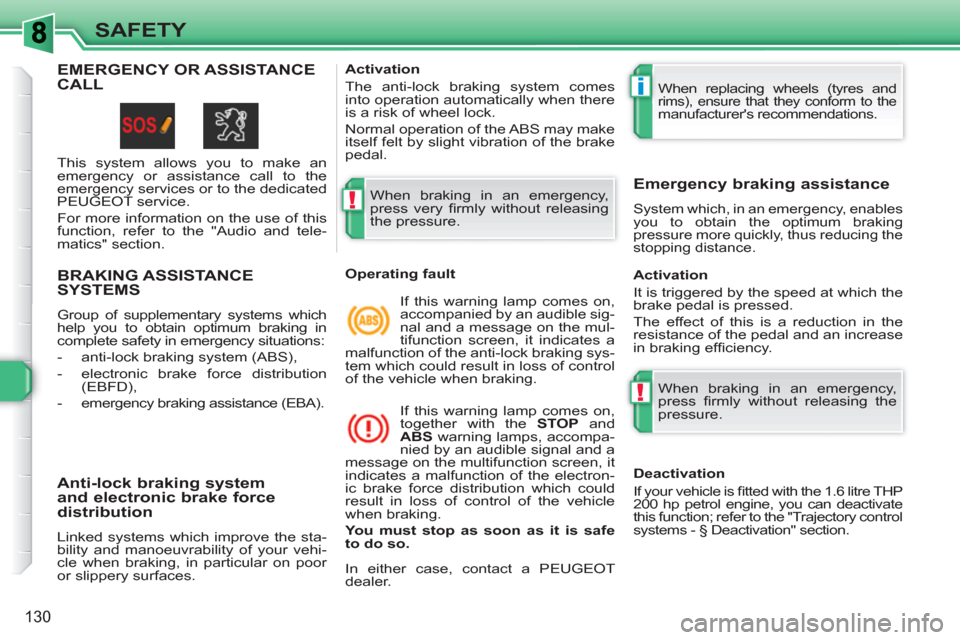
!
i
!
130
SAFETY
BRAKING ASSISTANCE SYSTEMS
Group of supplementary systems which
help you to obtain optimum braking in
complete safety in emergency situations:
- anti-lock braking system (ABS),
- electronic brake force distribution
(EBFD),
- emergency braking assistance (EBA).
Anti-lock braking system
and electronic brake force
distribution
Linked systems which improve the sta-
bility and manoeuvrability of your vehi-
cle when braking, in particular on poor
or slippery surfaces.
When braking in an emergency,
press very fi rmly without releasing
the pressure.
When replacing wheels (tyres and
rims), ensure that they conform to the manufacturer's recommendations.
Operating fault
If this warning lamp comes on,
accompanied by an audible sig-
nal and a message on the mul-
tifunction screen, it indicates a
malfunction of the anti-lock braking sys-
tem which could result in loss of control
of the vehicle when braking.
If this warning lamp comes on,
together with the STOP
and
ABS
warning lamps, accompa-
nied by an audible signal and a
message on the multifunction screen, it
indicates a malfunction of the electron-
ic brake force distribution which could
result in loss of control of the vehicle
when braking.
You must stop as soon as it is safe
to do so.
Emergency braking assistance
System which, in an emergency, enables
you to obtain the optimum braking
pressure more quickly, thus reducing the
stopping distance.
Activation
The anti-lock braking system comes
into operation automatically when there
is a risk of wheel lock.
Normal operation of the ABS may make
itself felt by slight vibration of the brake
pedal.
Activation
It is triggered by the speed at which the
brake pedal is pressed.
The effect of this is a reduction in the
resistance of the pedal and an increase
in braking effi ciency.
In either case, contact a PEUGEOT
dealer. When braking in an emergency,
press fi rmly without releasing the
pressure.
EMERGENCY OR ASSISTANCECALL
This system allows you to make an
emergency or assistance call to the
emergency services or to the dedicated
PEUGEOT service.
For more information on the use of this
function, refer to the "Audio and tele-
matics" section.
Deactivation
If your vehicle is fi tted with the 1.6 litre THP
200 hp petrol engine, you can deactivate
this function; refer to the "Trajectory control
systems - § Deactivation" section.
Page 133 of 336
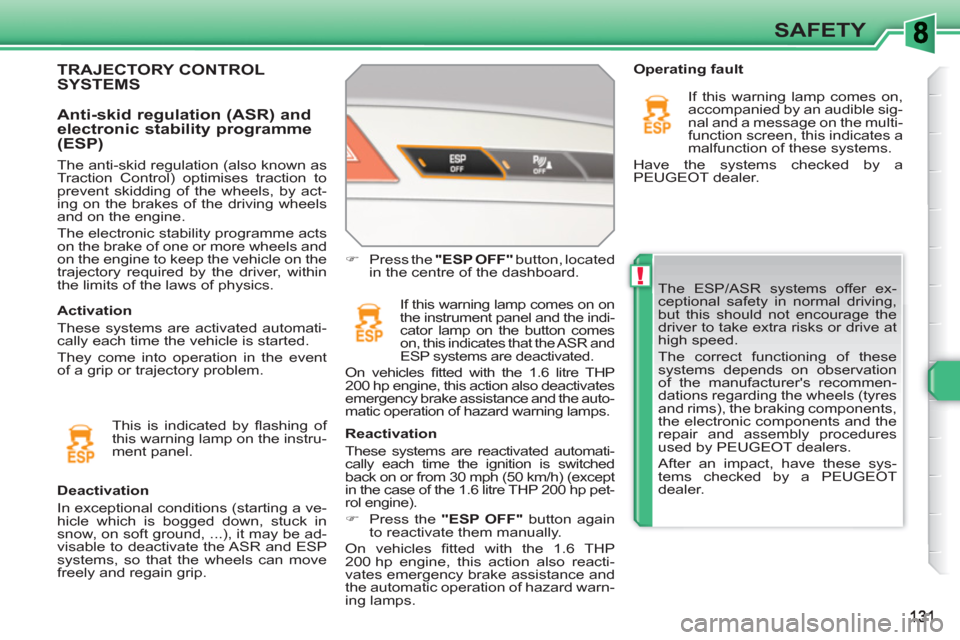
!
SAFETY
The ESP/ASR systems offer ex-
ceptional safety in normal driving,
but this should not encourage the
driver to take extra risks or drive at
high speed.
The correct functioning of these
systems depends on observation
of the manufacturer's recommen-
dations regarding the wheels (tyres
and rims), the braking components,
the electronic components and the
repair and assembly procedures
used by PEUGEOT dealers.
After an impact, have these sys-
tems checked by a PEUGEOT
dealer.
Deactivation
In exceptional conditions (starting a ve-
hicle which is bogged down, stuck in
snow, on soft ground, ...), it may be ad-
visable to deactivate the ASR and ESP
systems, so that the wheels can move
freely and regain grip.
�)
Press the "ESP OFF"
button, located
in the centre of the dashboard.
If this warning lamp comes on on
the instrument panel and the indi-
cator lamp on the button comes
on, this indicates that the ASR and
ESP systems are deactivated.
On vehicles fi tted with the 1.6 litre THP
200 hp engine, this action also deactivates
emergency brake assistance and the auto-
matic operation of hazard warning lamps.
Reactivation
These systems are reactivated automati-
cally each time the ignition is switched
back on or from 30 mph (50 km/h) (except
in the case of the 1.6 litre THP 200 hp pet-
rol engine).
�)
Press the "ESP OFF"
button again
to reactivate them manually.
On vehicles fi tted with the 1.6 THP
200 hp engine, this action also reacti-
vates emergency brake assistance and
the automatic operation of hazard warn-
ing lamps.
Operating fault
If this warning lamp comes on,
accompanied by an audible sig-
nal and a message on the multi-
function screen, this indicates a
malfunction of these systems.
Have the systems checked by a
PEUGEOT dealer.
TRAJECTORY CONTROLSYSTEMS
Activation
These systems are activated automati-
cally each time the vehicle is started.
They come into operation in the event
of a grip or trajectory problem.
Anti-skid regulation (ASR) and
electronic stability programme
(ESP)
This is indicated by fl ashing of
this warning lamp on the instru-
ment panel.
The anti-skid regulation (also known as
Traction Control) optimises traction to
prevent skidding of the wheels, by act-
ing on the brakes of the driving wheels
and on the engine.
The electronic stability programme acts
on the brake of one or more wheels and
on the engine to keep the vehicle on the
trajectory required by the driver, within
the limits of the laws of physics.
Page 138 of 336
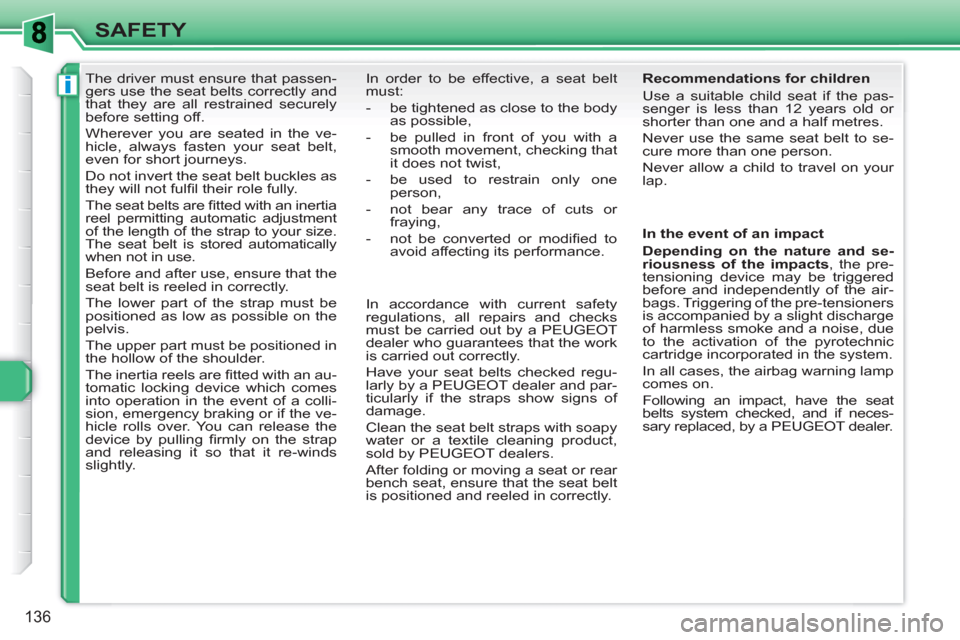
i
136
SAFETY
The driver must ensure that passen-
gers use the seat belts correctly and
that they are all restrained securely
before setting off.
Wherever you are seated in the ve-
hicle, always fasten your seat belt,
even for short journeys.
Do not invert the seat belt buckles as
they will not fulfi l their role fully.
The seat belts are fi tted with an inertia
reel permitting automatic adjustment
of the length of the strap to your size.
The seat belt is stored automatically
when not in use.
Before and after use, ensure that the
seat belt is reeled in correctly.
The lower part of the strap must be
positioned as low as possible on the
pelvis.
The upper part must be positioned in
the hollow of the shoulder.
The inertia reels are fi tted with an au-
tomatic locking device which comes
into operation in the event of a colli-
sion, emergency braking or if the ve-
hicle rolls over. You can release the
device by pulling fi rmly on the strap
and releasing it so that it re-winds
slightly. In order to be effective, a seat belt
must:
- be tightened as close to the body
as possible,
- be pulled in front of you with a
smooth movement, checking that
it does not twist,
- be used to restrain only one
person,
- not bear any trace of cuts or
fraying,
- not be converted or modifi ed to
avoid affecting its performance.
In accordance with current safety
regulations, all repairs and checks
must be carried out by a PEUGEOT
dealer who guarantees that the work
is carried out correctly.
Have your seat belts checked regu-
larly by a PEUGEOT dealer and par-
ticularly if the straps show signs of
damage.
Clean the seat belt straps with soapy
water or a textile cleaning product,
sold by PEUGEOT dealers.
After folding or moving a seat or rear
bench seat, ensure that the seat belt
is positioned and reeled in correctly.
Recommendations for children
Use a suitable child seat if the pas-
senger is less than 12 years old or
shorter than one and a half metres.
Never use the same seat belt to se-
cure more than one person.
Never allow a child to travel on your
lap.
In the event of an impact
Depending on the nature and se-
riousness of the impacts
, the pre-
tensioning device may be triggered
before and independently of the air-
bags. Triggering of the pre-tensioners
is accompanied by a slight discharge
of harmless smoke and a noise, due
to the activation of the pyrotechnic
cartridge incorporated in the system.
In all cases, the airbag warning lamp
comes on.
Following an impact, have the seat
belts system checked, and if neces-
sary replaced, by a PEUGEOT dealer.
Page 145 of 336
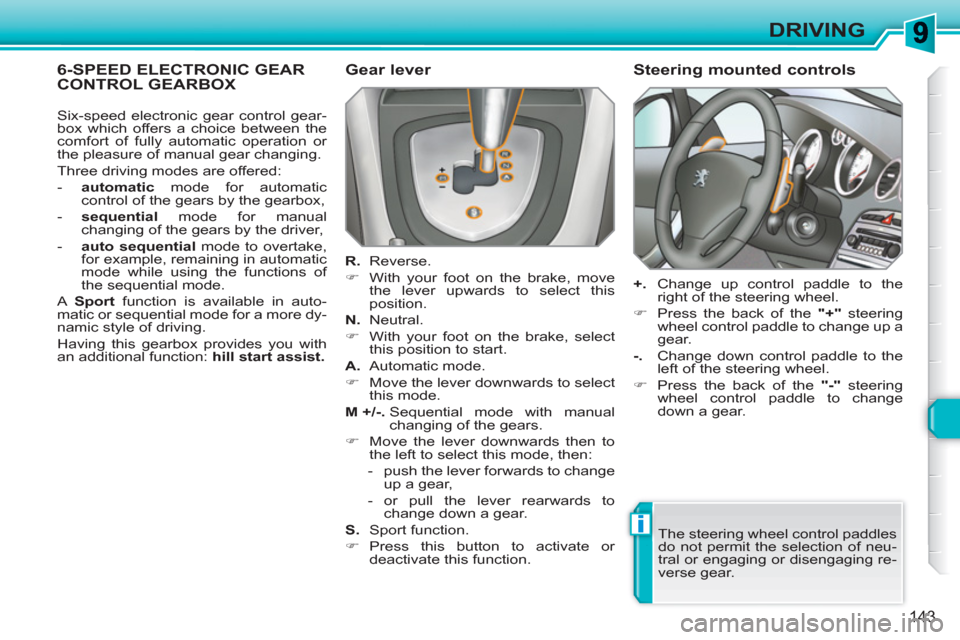
i
143
DRIVING
6-SPEED ELECTRONIC GEAR CONTROL GEARBOX
Gear lever
R.
Reverse.
�)
With your foot on the brake, move
the lever upwards to select this
position.
N.
Neutral.
�)
With your foot on the brake, select
this position to start.
A.
Automatic mode.
�)
Move the lever downwards to select
this mode.
M +/-.
Sequential mode with manual
changing of the gears.
�)
Move the lever downwards then to
the left to select this mode, then:
- push the lever forwards to change
up a gear,
- or pull the lever rearwards to
change down a gear.
S.
Sport function.
�)
Press this button to activate or
deactivate this function.
Steering mounted controls
+.
Change up control paddle to the
right of the steering wheel.
�)
Press the back of the "+"
steering
wheel control paddle to change up a
gear.
-.
Change down control paddle to the
left of the steering wheel.
�)
Press the back of the "-"
steering
wheel control paddle to change
down a gear.
The steering wheel control paddles
do not permit the selection of neu-
tral or engaging or disengaging re-
verse gear. Six-speed electronic gear control gear-
box which offers a choice between the
comfort of fully automatic operation or
the pleasure of manual gear changing.
Three driving modes are offered:
- automatic
mode for automatic
control of the gears by the gearbox,
- sequential
mode for manual
changing of the gears by the driver,
- auto sequential
mode to overtake,
for example, remaining in automatic
mode while using the functions of
the sequential mode.
A Sport
function is available in auto-
matic or sequential mode for a more dy-
namic style of driving.
Having this gearbox provides you with
an additional function: hill start assist.
Page 147 of 336
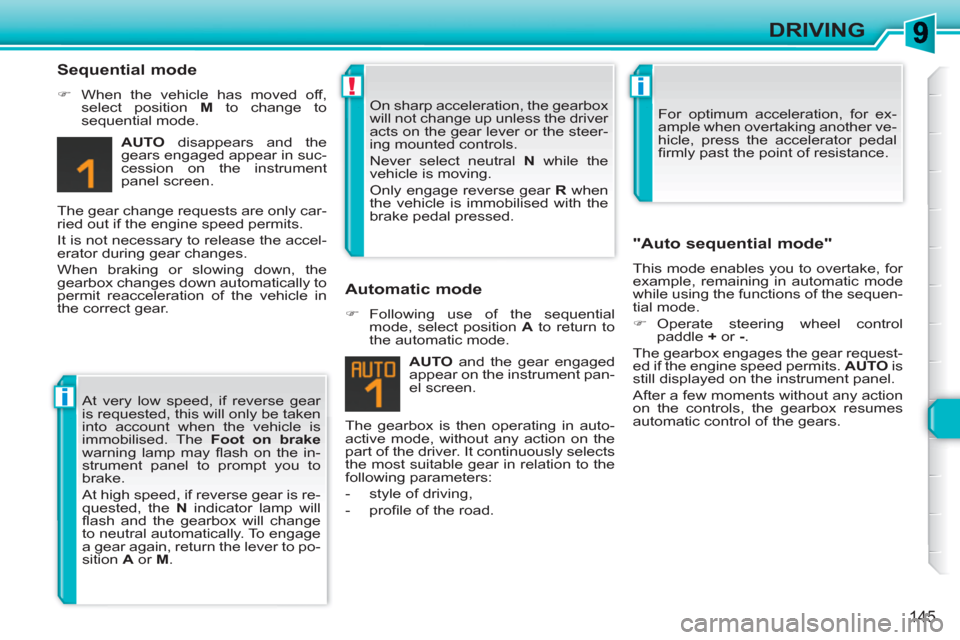
i
!i
145
DRIVING
Sequential mode
�)
When the vehicle has moved off,
select position M
to change to
sequential mode.
AUTO
disappears and the
gears engaged appear in suc-
cession on the instrument
panel screen.
The gear change requests are only car-
ried out if the engine speed permits.
It is not necessary to release the accel-
erator during gear changes.
When braking or slowing down, the
gearbox changes down automatically to
permit reacceleration of the vehicle in
the correct gear.
The gearbox is then operating in auto-
active mode, without any action on the
part of the driver. It continuously selects
the most suitable gear in relation to the
following parameters:
- style of driving,
- profi le of the road.
AUTO
and the gear engaged
appear on the instrument pan-
el screen.
Automatic mode
�)
Following use of the sequential
mode, select position A
to return to
the automatic mode.
"Auto sequential mode"
This mode enables you to overtake, for
example, remaining in automatic mode
while using the functions of the sequen-
tial mode.
�)
Operate steering wheel control
paddle +
or -
.
The gearbox engages the gear request-
ed if the engine speed permits. AUTO
is
still displayed on the instrument panel.
After a few moments without any action
on the controls, the gearbox resumes
automatic control of the gears. At very low speed, if reverse gear
is requested, this will only be taken
into account when the vehicle is
immobilised. The Foot on brake
warning lamp may fl ash on the in-
strument panel to prompt you to
brake.
At high speed, if reverse gear is re-
quested, the N
indicator lamp will
fl ash and the gearbox will change
to neutral automatically. To engage
a gear again, return the lever to po-
sition A
or M
. On sharp acceleration, the gearbox
will not change up unless the driver
acts on the gear lever or the steer-
ing mounted controls.
Never select neutral N
while the
vehicle is moving.
Only engage reverse gear R
when
the vehicle is immobilised with the
brake pedal pressed. For optimum acceleration, for ex-
ample when overtaking another ve-
hicle, press the accelerator pedal
fi rmly past the point of resistance.
Page 148 of 336

!!
i
146
DRIVING
Stopping the vehicle
Operating fault
With the ignition on, if this warn-
ing lamp comes on and AUTO
fl ashes, accompanied by an au-
dible signal and a message on
the multifunction screen, this indicates
a malfunction of the gearbox.
Have it checked by a PEUGEOT dealer.
It is essential to press the brake
pedal when starting the engine.
When parking, is it essential to ap-
ply the parking brake to immobilise
the vehicle, whatever the circum-
stances. When immobilising the vehicle,
with the engine running, it is es-
sential to place the gear lever in
neutral N
.
Before carrying out any work in the
engine compartment, check that
the gear lever is in neutral N
and
that the parking brake is applied. With the ignition on, if the warn-
ing lamp above and this warning
lamp come on, accompanied by
an audible signal and a message
on the multifunction screen, this indicates a
malfunction of the hill start assist system.
Have it checked by a PEUGEOT dealer.
Sport function
�)
Following selection of the sequential
mode or automatic mode, press
button S
to activate the Sport
function which offers you a more
dynamic style of driving.
S
appears next to the gear en-
gaged on the instrument panel
screen.
�)
Press button S
again to deactivate
the function.
S
is then cleared from the instrument
panel screen.
The Sport function is deactivated
each time the ignition is switched
off. Before switching off the engine, you can
choose to:
- move to position N
to engage
neutral,
- leave the gear engaged; in this
case, it will not be possible to move
the vehicle.
In both cases, it is essential that you ap-
ply the parking brake to immobilise the
vehicle. This warning lamp may also come on if
a door is opened.